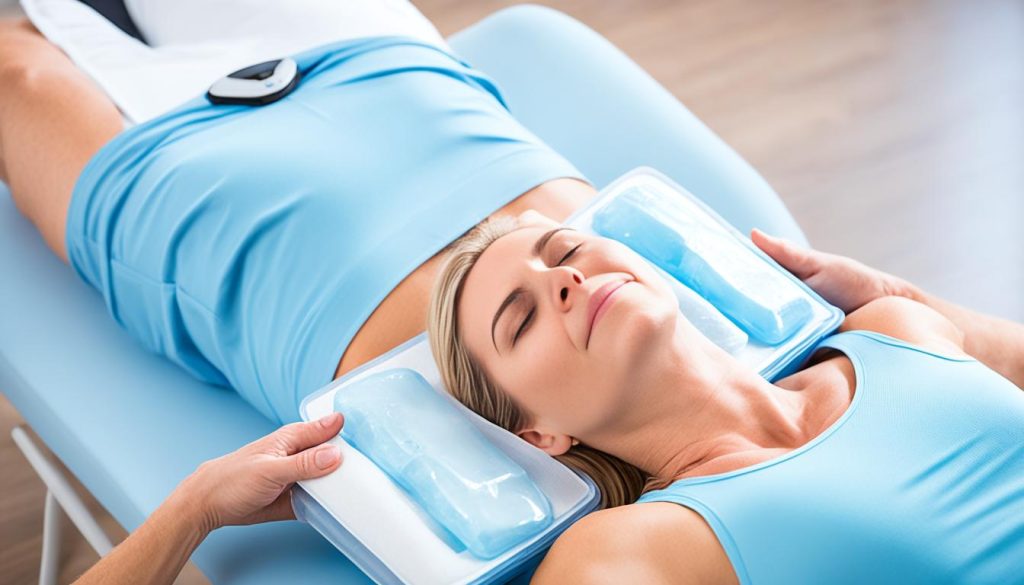Lower back pain can be a real nuisance, affecting our daily lives and overall well-being. When it comes to finding relief, many people turn to at-home remedies like heat and cold therapy. But which one is better? Let’s explore the benefits and best practices for using heat and cold therapy to manage lower back pain.
Heat and cold therapy are both effective options depending on the type of pain and its cause. For acute back pain caused by a direct injury, starting with cold therapy can help reduce inflammation and swelling. By applying a cold compress or ice packs to the affected area, you can ease discomfort and promote healing. However, it’s important to remember that cold therapy should be used within the first two days of an injury, and it should not be applied directly to the skin for an extended period of time.
On the other hand, heat therapy is beneficial for chronic back pain that lasts more than four weeks. Heat helps relax the muscles, reduces pain signals, and promotes healing. You can apply heat through various methods such as using electric heating pads, hot water bottles, baths, or adhesive heat wraps. However, it’s essential to ensure that the temperature is warm, not hot, and to avoid leaving heat therapy on the body for too long to prevent skin damage.
In some cases, using both heat and cold therapy can be advantageous. Before exercising, applying a warm compress can help relax the muscles and prepare them for movement, while using cold therapy after exercising can soothe any muscle soreness. Incorporating cold showers or hot baths can also enhance the effects of heat and cold therapy.
Remember, it’s important to use heat and cold therapy correctly and avoid using them in certain situations, such as open wounds or specific medical conditions. If your back pain persists or worsens, it’s always best to consult with a healthcare professional for further evaluation and guidance.
Stay tuned to discover more about managing lower back pain and other natural remedies to find relief.
What is Better for Lower Back Pain Heat or Cold?
When to Use Ice for Lower Back Pain?
Ice therapy, also known as cold therapy, is a beneficial approach for managing lower back pain, especially in cases of acute pain or pain caused by direct injury. This therapy involves the application of cold to the affected area, helping to reduce inflammation, swelling, and pain.
Ice therapy is particularly recommended within two days of an injury, as it can effectively minimize the initial inflammation response. By reducing swelling, ice therapy can help alleviate pain and create a more conducive environment for healing to take place.
In addition to injuries, ice therapy can also be helpful for managing lower back pain related to physical activity. Soreness resulting from exercise can be relieved by applying ice, as it helps to soothe the affected muscles and reduce discomfort.
Furthermore, ice therapy can be beneficial for individuals experiencing sciatica pain. Sciatica refers to a condition characterized by pain radiating along the sciatic nerve, often extending from the lower back down the leg. Applying ice to the affected area can help alleviate the pain and provide relief.
There are different methods to incorporate ice therapy for lower back pain. One approach is through massage therapy, where a professional therapist uses ice or cold packs to stimulate the affected area. Another option is using a cold compress at home, which can be easily made by filling a plastic bag with ice cubes or using a specially designed cold pack.
Guidelines for Ice Therapy
- Use ice therapy for acute back pain or immediate relief of pain and inflammation.
- Apply ice within two days of an injury or when experiencing soreness from exercise.
- Protect the skin by placing a cloth or towel between the ice pack and the skin.
- Do not leave ice directly on the skin for prolonged periods to prevent ice burn.
Ice therapy is a valuable tool in managing lower back pain. By understanding when and how to use ice therapy effectively, individuals can utilize this natural remedy to alleviate discomfort and support the healing process.

| Ice Therapy | Heat Therapy |
|---|---|
| Reduces inflammation and swelling | Relaxes tissues and decreases pain signals |
| Helpful for acute back pain or direct injuries | Effective for chronic back pain lasting more than four weeks |
| Is beneficial for relieving soreness from exercise and managing sciatica pain | Improves flexibility and promotes healing |
| Can be applied through massage therapy or using a cold compress | Applied through methods such as electric heating pads, hot water bottles, baths, and adhesive heat wraps |
| Use with caution and protect the skin to avoid ice burn | Avoid prolonged exposure to prevent skin damage |
When to Use Heat for Lower Back Pain?
Heat therapy is a natural and effective remedy for relieving chronic lower back pain that lasts longer than four weeks. It offers a range of benefits, from promoting relaxation in the tissues to reducing pain signals and facilitating the healing process.
There are different methods for applying heat therapy, depending on your preference and convenience. Electric heating pads, hot water bottles, baths, and adhesive heat wraps are all popular options for delivering soothing heat to the affected area. Remember, the temperature should be warm but not hot to avoid skin damage.
It is crucial to follow the recommended guidelines when using heat therapy for back pain relief. The heat therapy should not be left on the body for extended periods, as this can potentially lead to skin irritation. It’s advisable to use heat therapy for 15-20 minutes at a time, taking breaks if necessary.
While heat therapy has numerous benefits, it’s important to note that it is not recommended for acute injuries or certain medical conditions. Always consult with a healthcare professional to determine if heat therapy is suitable for your specific condition.
Incorporating heat therapy into your back pain relief routine can provide much-needed comfort and promote overall well-being. It’s a natural remedy that can be easily implemented at home.
Benefits of Heat Therapy for Back Pain
- Relaxes tissues in the affected area
- Reduces pain signals and discomfort
- Facilitates the healing process
- Improves blood circulation
- Promotes muscle flexibility and range of motion

| Heat Therapy Methods | Pros | Cons |
|---|---|---|
| Electric Heating Pads | – Easy to use – Adjustable temperature – Provides targeted heat – Reusable |
– Requires access to electricity – Can be expensive upfront |
| Hot Water Bottles | – Simple and affordable – Portable – Provides localized heat |
– Heat may dissipate quickly – Requires hot water source |
| Baths | – Offers overall relaxation – Soothes multiple areas at once |
– Requires access to a bath or shower – Not convenient for immediate relief |
| Adhesive Heat Wraps | – Easy to apply and wear – Provides continuous heat – Portable |
– Limited heat duration – Can be expensive if used frequently |
Using Heat and Ice Therapy for Back Pain
In some cases, incorporating both heat and ice therapy can provide effective relief for managing back pain. Each therapy has unique benefits and can be used at different times to address specific needs.
Heat Therapy for Lower Back Pain Relief
Heat therapy is commonly used to soothe chronic back pain and promote healing. Applying heat to the lower back helps relax the muscles, increases blood flow, and reduces pain signals. Here are some ways to incorporate heat therapy:
- Electric heating pads: These devices emit consistent heat and are adjustable to suit your comfort level.
- Hot water bottles: Fill a hot water bottle with warm (not hot) water and place it on the affected area.
- Baths or showers: Taking a warm bath or shower can provide overall relaxation and pain relief.
- Adhesive heat wraps: These convenient wraps can be easily applied to the lower back and provide continuous heat.
It’s important to avoid using excessive heat or leaving heat therapy on the body for too long to prevent skin damage. Heat therapy is not recommended for acute injuries or certain medical conditions, so it’s essential to consult with a healthcare professional.
Cold Therapy for Lower Back Pain Relief
Cold therapy, also known as cryotherapy, is effective for acute back pain or pain caused by direct injury. It helps reduce inflammation, swelling, and pain in the lower back area. Here are some ways to incorporate cold therapy:
- Cold compress: Apply an ice pack or a frozen gel pack wrapped in a towel to the affected area for 15-20 minutes.
- Massage therapy: Using ice cubes or an ice massage roller can provide targeted cooling and pain relief.
It’s important to protect the skin by not applying ice directly to it and avoiding prolonged exposure to cold therapy. Cold therapy should be used within two days of an injury and can also be helpful for relieving muscle soreness after exercise or soothing sciatica pain.
Combining Heat and Cold Therapy
Depending on the situation, using both heat and ice therapy in conjunction can provide additional benefits for managing back pain. For instance:
- Before exercising: Applying a warm compress to the lower back can help relax the muscles and prepare them for movement, increasing flexibility and preventing injury.
- After exercising: Using cold therapy, such as an ice pack, can help reduce muscle soreness and inflammation, promoting faster recovery.
Remember to always protect your skin from extreme temperatures and use heat and ice therapy in moderation. Maintaining a balanced approach to managing back pain is key, and consulting with a healthcare professional is advisable, especially if the pain persists or worsens.

Conclusion
Heat and ice therapy are effective and accessible at-home remedies for managing lower back pain. When it comes to acute injuries and immediate relief of pain and inflammation, ice therapy is recommended. Ice helps reduce swelling and inflammation, providing much-needed relief. On the other hand, heat therapy is beneficial for chronic pain and promoting healing. It relaxes tissues, decreases pain signals, and supports the healing process.
In certain situations, using both heat and ice therapy can be advantageous, such as before and after exercising. Prior to exercising, applying a warm compress can help relax the muscles and prepare them for movement. After exercising, using cold therapy can soothe any muscle soreness and reduce inflammation.
It’s essential to use heat and ice therapies correctly to ensure optimal results. Protecting the skin is crucial, and both therapies should be used with caution in certain medical conditions. If back pain persists or worsens, it’s always advisable to consult with a healthcare professional for further evaluation and guidance.




